

 Much information and literature has been published in books and online about the 1851 Great Exhibition but some very basic facts are that it was organised by Prince Albert and others. Its prime motive was for Britain to make “clear to the world its role as industrial leader.”
Much information and literature has been published in books and online about the 1851 Great Exhibition but some very basic facts are that it was organised by Prince Albert and others. Its prime motive was for Britain to make “clear to the world its role as industrial leader.”
The Great Exhibition took place in Hyde Park, London, from 1 May to 15 October 1851. The building was designed by Joseph Paxton with support from structural engineer Charles Fox, It took the form of a massive glass house, 1848 feet long by 454ft wide. The building was later moved and re-erected in 1854 in enlarged form at Sydenham Hill in South London, an area that was renamed Crystal Palace. It was destroyed by fire on 30 November 1936.
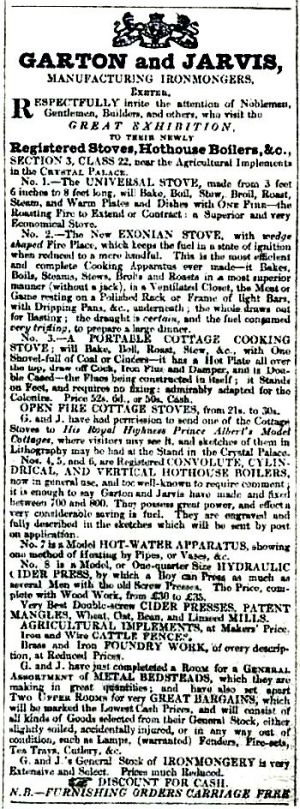 Up until August 2021 I was unaware of any notification or invitation to the general public by the company to visit their stand at the Great Exhibition. However, this advert (right), placed in the Western Times on 31st July 1851, not only confirms this invite but also goes to great lengths to describe to those attending the Exhibition exactly what the Company had placed on display at their stand near the Agricultural Implements area. An identically worded advertisement also appeared in the Flying Post on the same date.
Up until August 2021 I was unaware of any notification or invitation to the general public by the company to visit their stand at the Great Exhibition. However, this advert (right), placed in the Western Times on 31st July 1851, not only confirms this invite but also goes to great lengths to describe to those attending the Exhibition exactly what the Company had placed on display at their stand near the Agricultural Implements area. An identically worded advertisement also appeared in the Flying Post on the same date.
We can only guess at the logistics involved in getting all the goods and items listed in the advert to the Exhibition site. The scene at that time must have been chaotic as countless exhibitors with horse drawn carts and wagons jostled and struggled to get their products and exhibits to the Exhibition Site and then to offload and attempt to set up their Stands ready for the opening day on 1st May 1851.
Chapter 5 of Golden Hammer, titled ‘Greater Yet’, includes information about the event and the exhibits that Garton & Jarvis displayed, and the subsequent benefits it enjoyed as a result. The Certificate (above) was issued to all exhibitors but personalised with the Exhibitor’s name. The medals (below right) embossed with the Company’s name, are still in the Company archives.
The Catalogue entry was summarised as shown above left, but a more comprehensive description of the goods displayed is reproduced below together with the grammar and spelling of that time.
483 GARTON & JARVIS, Exeter – Inventors and Manufacturers. Improved universal cooling apparatus, or range-stove, including mantelpiece, with oven, hot-closet, and hot-plate and expanding and contracting fireplace. Exonian Cooking apparatus, cast iron, hot-closet, with large ventilating roasting-chamber, dripping-pan to draw out, hot-plate, and rings and covers for broiling. Portable Cottage Cooking Stove, with oven, hot–plate, boiler, and draw-off cock. Wrought-iron cylindrical hot-house boiler, being a cylinder of water with fireplace in the centre, and a thin sheet of water at the end. Solar, or convolute hot-house boiler, is a sheet of water coiled in the form of a scroll, with fire in the centre and fixed horizontally. Double vertical hot-house boiler (cast) with the fire in its centre, the flame, leaving the lower boiler, impinges on the crown-boiler. Model hot-water apparatus, for warming hot-houses, conservatories, churches and private residences. Working model double-action hydraulic cider-press.
The Cottage Stove that Prince Albert was attracted to was installed in one of his Model Cottages in Hyde Park. Each house was designed to accommodate four families in separate flats. Each flat was provided with running water and internal sanitation, with a separate kitchen area (or scullery) and three bedrooms, essential for the large families of the day. The construction of the house was simple, robust and economical as well as being attractive to look at. The entire building was dismantled and re-erected in Kennington Park, South London, where it still stands to this day (but without the stove!) The inscription on the balcony reads “Model Houses for families, Erected by H.R.H. Prince Albert” The premises are currently (2020) occupied by the Charity ‘Trees for Cities’.
Chapter 5 of Golden Hammer includes a letter dated October 1851 from a certain Isaac Billett from Moreton Hampstead which, in addition to reporting Prince Albert's complimentary remarks, expresses his satisfaction with his own purchase of a Cottage Stove. In fact he bought two Cottage Stoves, one on the 11th August and another on the 29th August 1851. The two were 2’ 6” wide versions and they retailed at £2.10s. 0d each.
Isaac Billett was a resident of Moretonhampstead and was involved in the rope making business which was operated from a property called ‘Battenbury’ on Court Street. He is likely to have been a Unitarian in belief and it is reported in the Exeter Flying Post on the 29th August 1850 that a ‘Public tea for the children belonging to the Cross Street Unitarian Chapel Sunday School was held at a place appropriated for the occasion, as last year, the Rope Walk in the manufactory of Mr Isaac Billett.’
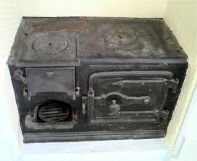 |
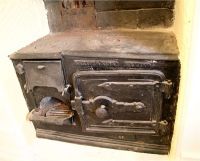 |
|
| Cottage Stove, surviving at Sidford, Devon |
Cottage Stove, awaiting restoration at Chittlehampton, N.Devon | |
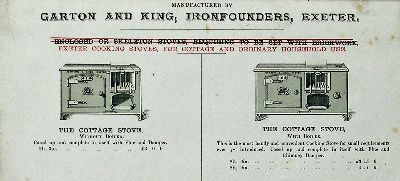 |
||
| A later Cottage Stove advert, post 1865, the company now Garton & King |
||
 The illustrations seen in the Golden Hammer booklet were drawn by Sam Ellacott. He had actually had a few years of employment in the foundry at Garton & King in the early 1930s. In 1953 the second in the ‘Outline’ series of Methuen & Co Ltd’s Source books that were written and illustrated by Sam Ellacott was published. It was entitled ‘The Story of the Kitchen.’ The illustration on the right shows the Cooking Range supplied to the Prince Consort and although he does not refer directly to Garton & Jarvis in the text, the name is visible on the stove and on the mantle. A total of eight books in the Outline Series were written and illustrated by Sam Ellacott (see more).
The illustrations seen in the Golden Hammer booklet were drawn by Sam Ellacott. He had actually had a few years of employment in the foundry at Garton & King in the early 1930s. In 1953 the second in the ‘Outline’ series of Methuen & Co Ltd’s Source books that were written and illustrated by Sam Ellacott was published. It was entitled ‘The Story of the Kitchen.’ The illustration on the right shows the Cooking Range supplied to the Prince Consort and although he does not refer directly to Garton & Jarvis in the text, the name is visible on the stove and on the mantle. A total of eight books in the Outline Series were written and illustrated by Sam Ellacott (see more).
Images and details of the Exonian Stove, also displayed at the Great Exhibition appear on this site on the Cooking Equipment page.
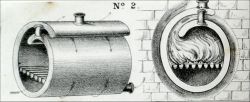 The Convolute Boiler, which was also on display on the Company Stand at the Exhibition, is described, in the language of the period as:-
The Convolute Boiler, which was also on display on the Company Stand at the Exhibition, is described, in the language of the period as:-
The Convolute Boiler is a very powerful boiler. The Fire-place being within the boiler and the heat is not allowed to escape until it has traversed the outer surface. This boiler is only applicable for heating extensive edifices, being much too powerful for ordinary houses. They are manufactured in various sizes.
Lastly, a real curiosity! This advertisement (right) apeared in the Taunton Courier on 5th March 1851. Did Garton & Jarvis complete Mr Young's invention in time to exhibit it (or use it!) at the Exhibition?
Buoyed up no doubt by the success Garton and Jarvis enjoyed as a result of exhibiting at the Great Exhibition they decided also to exhibit in the British Section of the Paris Universal Exhibition in 1855. Unfortunately the only documentation relating to this event that I have sourced is a copy of the Catalogue of Works exhibited in the British Section of the Exhibition which states:-
Class 9. Heat, Light & Electricity. Section 5, Production and Employment of Heat and Cold in a Domestic Economy. 472 Garton & Jarvis, 190 High Street, Exeter. Cooking Stoves.
Unfortunately there’s nothing on record as to the logistics of getting goods and display equipment from Exeter to the Paris site and no visual record has been found yet of that ‘Section 5’ but I have included an image of that period of the Paris Exhibition Premises.
Updated August 2021
Top of the page
See also:
Golden Hammer Chapter 5 — Flying the Flag
Cooking Equipment — Heating Equipment
Wheels & Gears (Royal Show 1952)
Sitemap / Contents